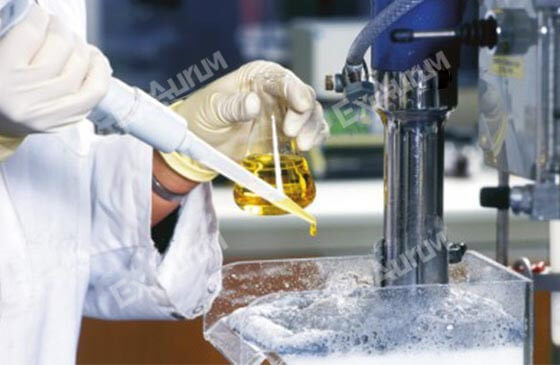2019-05-24 Views:3203
Warm Tip: If you want to know more information, like quotation, products, solutions, etc., please Click here ,and contact us online.

It is well known that the commonly used flotation reagent in flotation process include collectors, foaming reagents, and conditioners. What is the suitable flotation reagent dosage used in flotation process, how to configure it, what is the right order of flotation reagent dosing, and how to add flotation reagent. The following article will introduce the instructions for using flotation reagent.
When using flotation agents, the dosage of each agent should be adjusted. Insufficient or excessive dosage will lead to deviation in the effect of flotation process, and also affect the cost of flotation process. The influence of various flotation reagent dosage on mineral processing effect are as follows:
(1) The amount of collector is insufficient, and the hydrophobicity of minerals is poor, resulting in the decline of mineral recovery rate. Too much collectors lead to the mixture of flotation reagent and concentrate, the quality of concentrate will decrease, and the subsequent separation process of flotation will become more difficult.
(2) Insufficient amount of foaming agent makes it difficult to form a uniform and stable foam, and minerals enter normally, which affects the flotation process effect eventually. Excessive foaming agent dosage leads to excessive stickiness and stability of the foam, and the “chute” phenomenon of flotation cells appear, which destroys the normal flotation process and causes difficulties in conveying the concentrate.
(3) Insufficient activator dosage result in poor activation ability. Excessive activator dosage will destroy the selectivity of flotation process.
(4) Insufficient amount of inhibitor, impurities are not removed clearly, and the grade of concentrate is low. Overdose inhibits the minerals flotation and reduces the recovery rate.
The choice of preparation methods of flotation reagent is mainly depends on the different properties, adding methods and flotation reagent functions. Common preparation methods are as follows:
(1) Most of the flotation reagent which are soluble in water are directly formulated into 2% to 10% aqueous solutions (such as Xanthate, copper sulfate, water glass.)
(2) Solvent preparation, some water-insoluble flotation agents, can dissolve the flotation agent in a special solvent, for example, Xanthate is insoluble in water, but soluble in 10% to 20% aniline solution. Only after Xanthate being combined with aniline solution to form an aniline mixture, the flotation and collection process can be carried out; for example, Dithiophosphate is insoluble in water but soluble in alkaline sodium hydroxide solution, so the first step is to use Dithiophosphate. An alkaline solution of sodium hydroxide is then added to the flotation cells with an alkaline mixture of Dithiophosphate and sodium hydroxide.
(3) Prepare suspension or emulsion. For some insoluble solid flotation reagent, prepare emulsion for use. If the lime solubility in water is very small, directly use aqueous solution for flotation process, the amount of flotation reagent is very small, it is difficult to achieve the flotation effect, can be ground into powder lime water into emulsion suspension (lime milk), can also be added directly to the powder lime ball mill and mixing bucket for flotation.
(4) Saponification. For fatty acid collectors, saponification is the most common method. For example, when hematite is selected, the oxide wax and tart oil are used together as a collector. In order to saponify the tal oil, when the agent is formulated, about 10% of sodium carbonate is added, and heated to form a hot soap solution.
(5) Emulsification, emulsification is carried out by ultrasonic emulsification or mechanical strong agitation. For example, fatty acid and diesel flotation reagent can increase their diffusion in the pulp and improve the effect of the flotation reagent. Many surface activating materials can be used as emulsifiers for emulsification.
(6) Acidification, when using a cationic collector, due to its poor solubility, it is necessary to carry out acidic pretreatment with hydrochloric acid or acetic acid, and then dissolve the cationic collector in water for flotation.
There are two kinds of dosing methods commonly used in flotation reagent: one-time addition and batch addition. One-time addition is to concentrate the medicines once before the rough selection operation, so that the added concentration of the medicine is high and the addition is convenient. Generally, for drugs that are easily soluble in water, are not taken away by the foam, and are not easily reacted in the slurry and are ineffective, a one-time dosing such as lime or soda is often used.
The batch dosing is divided into several batches along the thick, fine and sweeping lines. Generally, 60%~70% of the total amount is added before the flotation, and the rest are added in batches according to the flotation process.
There are many kinds of flotation reagent, and the functions of various medicines in floating separation are also different. There are many things to be aware of, and only the fully grasped quantity of flotation medicine can achieve the best effect of flotation.
 +86 15311826765
+86 15311826765
 luli@xinhaimining.net
luli@xinhaimining.net
 No. 188, Xinhai Street, high-tech Industrial Park, Fushan District, Yantai, Shandong, China.
No. 188, Xinhai Street, high-tech Industrial Park, Fushan District, Yantai, Shandong, China.
